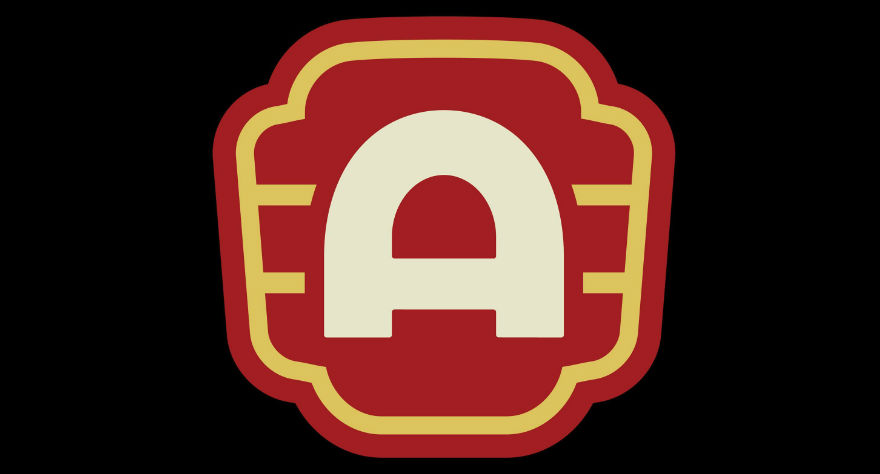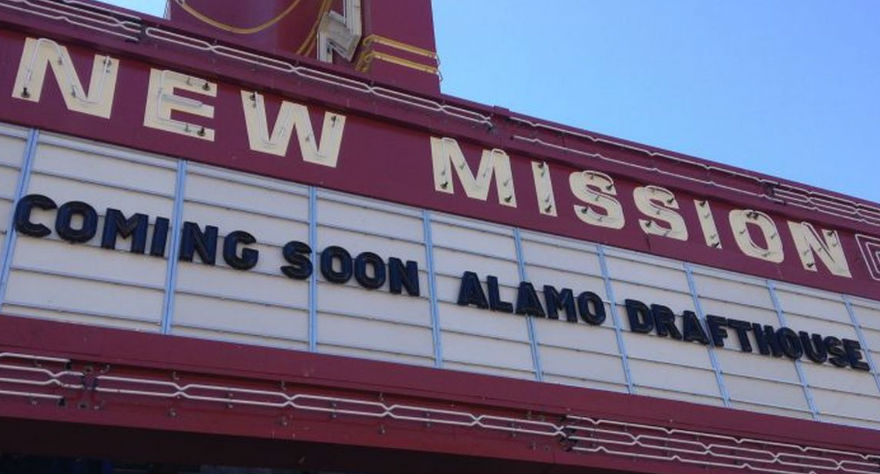Alamo Drafthouse SF Opens With ‘Star Wars,’ Five Screens and Loads of Queso

Standing in defiance of the techie takeover that’s been wiping clean San Francisco’s weird, colorful corners and pockets, the 100-year-old New Mission Theater—following a $10 million renovation by Alamo Drafthouse—opens its doors tomorrow, inviting us to dine on high-end finger food as we watch movies of all shapes and sizes within its historic walls.
For its grand opening, the theater will be playing Star Wars: The Force Awakens on all five of its screens. Moviegoers are offered assigned seating and can order food and drink throughout the movie via a silent ordering system involving pencils, paper, ninja-like servers and a whole lot of nervous hand gesturing. Not a perfect system by any means, but all the scrambling adds to the Alamo ambiance.
The Alamo Drafthouse Cinema chain was founded by Tim League in 1997 and has since expanded to 20 locations across the U.S., the New Mission being the latest addition. League’s hired former Roxie Director of Programming Mike Keegan to run the theater and, considering the man’s prior accomplishments (he’s helped program many of SF Indiefests wild and weird events and once organized a cat video film festival), San Franciscans are in for a treat. Helping Mike ensure the theater is an active contributor to the Mission District community is Private and Community Events Director Elizabeth Duran.
The theater’s adjoining bar, Bear Vs. Bull, will act as a separate entity; you can grab drinks before or after a movie or simply stop by and hang without purchasing a ticket at all. Beverage Director Isaac Shumway and Chef Ronnie New will be sure to keep your belly happy as you enjoy a night out with your buddies and/or significant other.
Sitting in front of one of the theater’s beautiful screens, I spoke with League and Keegan about the future of the New Mission and the journey that got them to this point. For more info, visit drafthouse.com/sf

As far as magnitude goes, there’s no bigger way to open this theater than on this weekend, with this movie.
Mike: We like to live by the seat of our pants, and there’s nothing more terrifying than opening a giant project, years in the making, with unrealistically high expectations!
I think the both of you have done countless cool things for the film community, kind of keeping the game off-balance with your ideas. Talk about coming together to work on this particular project.
Tim: We’ve known each other for a little while. I think we met through a mutual friend—it’s a really small world of people who do this type of programming. Our friend said, “You guys should meet—Mike’s nice!” And this guy will tell you if a guy’s not nice. [laughs] We chatted and Mike had left the Roxie and was out doing cat fancier tours or whatever it was. [laughs] It wasn’t really a formal process. It’s cool in this world because you’re kind of judged by your past work. We liked what he had been doing and thought it would be a good cultural fit for Drafthouse.
I’ve enjoyed your work at the Roxie very much over the years, Mike. This is a great, big new platform for you. What can we expect from you in the future?
Mike: The cool thing is, it’s five screens. You have flexibility because you have everything from a 320-seat room to a 34-seat room. You can basically show the best version of whatever should play in each room. You could play a masterpiece gem in a 34-seat room and do great, and you can have a four-quadrant Marvel movie in the big room. Everyone’s psyched and everyone’s happy. You hope that the audience will get to a point where they’d want to see all five things and that they feel like this is their place.
Tim: That sense is what’s pretty unique about our company, in a way. We’re doing some pretty interesting, almost subversive advertising for people who are watching some pretty down-the-middle movies. It’s like, “You like movies? How about these movies you may not have heard of?” It’s a way of converting a lot of people who may not know a lot about film history to come check out some other stuff after they’ve watched something like Star Wars, for example.
Mike: I feel like, over the past fifteen years or so, there’s been much less of a divide between high and low art. “Content” is a big word going around—people are just open to things that interest them. Whether it’s a stuffy art movie, a crass action movie or anywhere in between. It’s the right time to open a place like this.
With The Hateful Eight, particlarly the road show version, Quentin Tarantino is trying to give people a movie experience they can’t replicate at home. Your company does that kind of work as well. Talk about the importance of watching movies in wild, weird ways.
Tim: We look at ourselves as not necessarily competing against home video. We look at ourselves as an option for people deciding on what to do when they’re outside the house. This experience, from beginning to end, has to be compelling enough for people to choose it over going to a comedy club or going out for drinks. It’s an out-of-the-house entertainment option. Sometimes it’s more over-the-top for us. But I just like watching a movie. The technical aspects, the food and beverage—that’s all a part of just watching a movie.
A lot of the new companies that have popped up in San Francisco have sort of taken over and farmed new money without giving back to the community. It seems like this theater will play a big part in preserving the integrity and authenticity of our city.
Mike: We have a Community Director, Liz Duran, who’s from KQED, Sketchfest and the San Francisco Film Society. She’s on the ground, letting neighborhood organizations know that we’re here and we want to work with them. Kids can come watch movies on the weekend for a dollar. We’re here for everything.
The queso’s still on the menu!
Tim: That’s the only holdout. It’s a brand new menu except for the queso. If you’ve lived in Austin, that’s the number one question me and Mike have been fielding. “You’re bringing the queso, right?” People who aren’t from Austin have no idea what you’re talking about. [laughs]
So this is the first theater in the Alamo chain to have a unique menu?
Tim: Yeah. What we normally do is, we have a core menu, and we hire a local chef in the market and they change about 25% of it or so. Then they work on rotating specials once a quarter. If Hateful Eight is coming out, they’ll make a special menu for it. That kind of stuff. For this one…so many things are unique about this facility. I wanted the San Francisco theater to be very special, so we spent a long time trying to find a chef that we liked and was also a big movie fan. I wanted this to be a dream job for that person.
Would you say you created a dream job for yourself?
Tim: That’s exactly what I did. I was an engineer and I didn’t like it at all. I got there right on time, left right at five and took an abnormally long lunch break. I would leave my door open, you know? [laughs] When I was 21-years-old I immediately leapt into the middle class, but it wasn’t how I wanted to retire. My satisfaction came after 5 o’clock. Now, I love what I do.
I think what’s cool about you guys is that you’re a chain but you don’t feel like a chain. You’ve grown and done it the right way. How big can the company get? How big do you want it to get?
Tim: I set a goal to be at 50 locations by 2018, and then we were going to assess it and see how we did. If it still felt right, we could go bigger. I don’t know. I’m focused on that 2018 number. It’s already gotten really interesting. We were talking to the VP of Disney because they like what we’re doing. We can find smaller movies and open a movie across our circuit. That’s how we started our distribution company. Anomalisa is Paramount, but it’s also a challenging film. It’s going to be hard for that film to find an audience if it doesn’t get an Academy Award. That’s a movie where everyone on the team loves it and we’re going to collectively dive in and do everything we can. We worked directly with the studio. We said, “We’re going to post some numbers because this movie is extremely special.” We want to share it with as many people as possible. You can’t do that as a single-screen theater. Now that we’re bigger, we can make some noise for a movie like that.
Sometimes I go to the theater and I look around, and no one looks like they’re actually present. Their mind is somewhere else, their hands are itching to grab at their phones.
Tim: I think that speaks to why our no talking/no texting policy is so important. Not to sound pretentious or old-fashioned, but it’s so crazy to me what’s happened to people throughout their day. You could be having a conversation with somebody and it feels like they’ve gotten bored with what you’re saying and they pick up their phone and multi-task. Going to see a movie and making this mandatory situation happen where you have to put your phone away and focus on something that’s longer than a minute is actually kind of important, to shut down for 90 minutes and dissolve into a movie.
Somebody asked me, “What do you think about the future of movies? What will movies be like in 25 years?” I want it to be exactly what it is today, which is exactly what it was in the ’40s. I want the lights to go down and you just lose yourself in a story. No bells, no whistles. I don’t want anything more.
